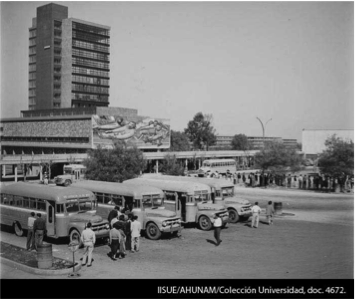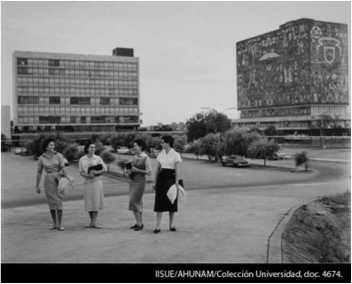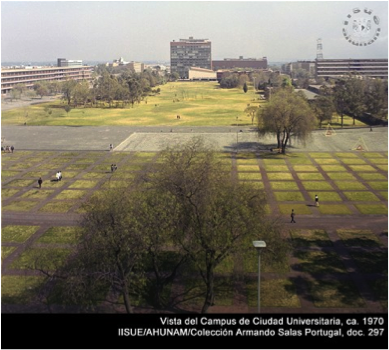Construction of the Campus of Ciudad Universitaria
The first plans for an all-embracing “University City” (Ciudad Universitaria) campus can be found in a thesis presented by architecture students in 1929. These plans called for the University to be built on a site in the south of the city known as Huipilco. It was not until 1945, however, that the appropriations act regarding the “foundation and construction of Ciudad Universitaria was finally decreed.
 The design of the campus was awarded to architects Mario Pani, Enrique Moral and Mauricio M. Campos, whose plans were chosen from among those submitted in a contest held in the National School of Architecture.
The design of the campus was awarded to architects Mario Pani, Enrique Moral and Mauricio M. Campos, whose plans were chosen from among those submitted in a contest held in the National School of Architecture.
Groundbreaking occurred in 1949, but soon floundered due to insufficient funding. In order to secure the support of President Miguel Aleman, the University Patrons Foundation was reorganized. The Bank of Mexico’s president, Carlos Novoa, was tapped to preside and Eduardo Suarez and David Thierry were also seated on the board.
These personages allowed the foundation to approach the Mexican President and thereby procure the funding needed to continue work on the project.
The campus was designed on the principle of maximizing communication between faculties. With input from professors, students and researchers, the designers included the Museum of Art in order to showcase the wide expanse of Mexican art through time.
With the help of the University Patrons Foundation, Carlos Lazo was able to carry through the construction plans in an orderly, economic and expedient manner, with major work finished in less than three years. On November 20th, 1952, President Miguel Aleman presided over the Ciudad Universitaria dedication ceremony.
 In 1953, Nabor Carrillo was appointed Rector of the University. He made important contributions to ensuring the termination of diverse buildings and the implementation of transportation and housing infrastructure. He also was a key player in securing funding to move the many schools and faculties to their new quarters on the campus.
In 1953, Nabor Carrillo was appointed Rector of the University. He made important contributions to ensuring the termination of diverse buildings and the implementation of transportation and housing infrastructure. He also was a key player in securing funding to move the many schools and faculties to their new quarters on the campus.
Finally, on March 22, 1954 in a ceremony held in the University Board of Governors Hall in the Rectory Tower, President Ruiz Cortines inaugurated the first classes imparted on the new campus, thereby handing over the new “University City” to the UNAM community.
World Heritage Site
By unanimous vote, the Ciudad Universitaria (CU) campus of the UNAM was included in the UNESCO List of World Heritage Sites at its convention held in New Zeeland on June 28th, 2007, and it was officially enrolled on the World Heritage Site ledger on July 2nd, 2007.
According to the text of the communiqué: “The urbanism and architecture of the Central University City Campus of UNAM constitute an outstanding example of the application of the principles of 20th Century modernism merged with features stemming from pre-Hispanic Mexican tradition. The ensemble became one of the most significant icons of modern urbanism and architecture in Latin America, recognized at universal level.”
 The design and construction of the Central University City Campus is the work of Mexican architects and workers, who from the perspective of the European rationalist school employ lines and materials of a nationalistic nature to achieve a unified, functional and aesthetic result that is enhanced by major works by leading artists of the Mexican muralist movement, including Juan O’Gorman, David Alfaro Siqueiros, Diego Rivera and José Chávez Morado, whose contributions are absolutely singular and inimitable.
The design and construction of the Central University City Campus is the work of Mexican architects and workers, who from the perspective of the European rationalist school employ lines and materials of a nationalistic nature to achieve a unified, functional and aesthetic result that is enhanced by major works by leading artists of the Mexican muralist movement, including Juan O’Gorman, David Alfaro Siqueiros, Diego Rivera and José Chávez Morado, whose contributions are absolutely singular and inimitable.
CU is situated on a 7,000+ year-old igneous flow known as the “Pedregal” in the south of Mexico City. Before moving to the new CU campus, the university was installed in diverse buildings in downtown Mexico City.
The CU World Cultural Site embraces the campus’s first circuit, originally inaugurated in 1952, and fifty buildings within the central nucleus consisting of 176.5 hectares, which constitutes about 25% of the entire campus complex. The site is delimited by the Olympic Stadium to the east, the Sports Complex to the south, the Faculty of Medicine to the west and the Faculties of Philosophy and Letters, Law and Odontology to the north.





